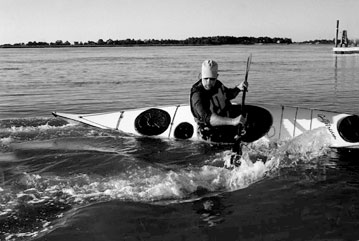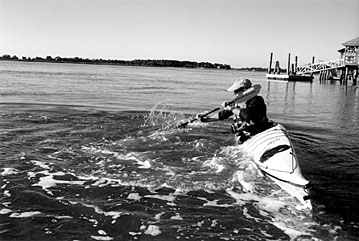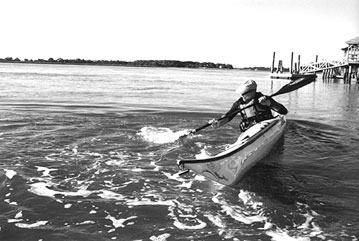There are often times when you need to get your kayak turned quickly. You can paddle backward on one side of the kayak and then forward on the other, but that approach takes a lot of strokes and time, and it requires shifts in balance that could be especially difficult in rough water.
I discovered an effective turning technique that combines a high-brace turn with a transition to a reverse sweep as the kayak slows. Because the power face is used for the reverse sweep, I call this technique the Power-Face Reverse Sweep. The high-brace position provides good support-even with an extreme lean to make the kayak pivot faster-for a strong, quick, and effective turn that works well in both rough water and surf conditions. I often use the Power-Face Reverse Sweep in surf to make quick turn-arounds, especially if I am trying to get turned around to catch a wave. This stroke is also very useful when I am leading groups or classes, and need to turn around quickly to check on someone.
This technique flows easily and naturally from the high-brace turn. I find that the combination works best if the high brace is initiated well toward the stern. As the kayak slows, tighten your abdominal muscles and rotate your torso to bring the paddle forward through the water (just as you would in performing a standard reverse sweep from a low-brace turn). The difference is that the paddle is held in a high-brace position with the wrists cocked back so that the Power-Face of the blade is used for the sweep.
The blade begins nearly flat on the water, at only a slight planing angle to keep the blade from plunging. As the torso rotates and brings the paddle forward through the water, the angle of the blade changes, becoming nearly vertical by the time the paddle is perpendicular to the kayak (again, just as in a standard reverse sweep). The planing angle can be adjusted throughout the stroke for greater support, as necessary.
With the support provided by the stroke, you can lean the boat easily throughout the turn: the greater the lean, the quicker the turn. At the end of the arc, as if doing a sculling stroke, uncock the wrists to rotate the paddle so that what was the trailing edge becomes the leading edge. Now skim the blade, power-face down, back over the water toward the stern. Then cock the wrists to rotate the paddle, and sweep forward again. Repeat until the turn is completed.
Like the low-brace turn with a standard reverse sweep, the high-brace turn with a Power-Face Reverse Sweep is a braking turn-that is, forward momentum slows, then stops after the turn is initiated.
The stroke does not have to be preceded by a high-brace turn to be effective. If a high-brace turn (which assumes forward momentum) is used to initiate the maneuver, the brace and sweep result in a braking turn and will stop you; but, the turns are often nearly 180 degrees, so I am reversing direction anyway, in most cases.
What about turning from a full stop? So far I’ve described the Power-Face Reverse Sweep only in combination with a high-brace turn, which requires forward momentum; but, like the reverse sweep, the technique is a useful turning stroke by itself-an alternative to, not a replacement for, the reverse sweep. The paddler is simply doing a reverse sweep from a high-brace position, gaining greater leverage and greater support than in the low-brace position.
When repeated multiple times, the technique has some similarities to sculling for support. Both share a figure-eight motion but, in this sweep, the figure-eight has little depth and is far more elongated: As the blade nears the bow, the stroke becomes a bow pull from a high-brace position, causing the bow to side-slip in the direction of the turn. At the end of the sweep, a wrist flick flips the paddle blade over as it leaves the water, and the trailing edge again becomes the leading edge. Instead of coming back into the water, however, the blade skims lightly over the surface toward the stern to start another sweep.
Once you have the kayak pointed in the direction you want to go, you can easily make a transition to a forward stroke at the end of the sweep-similar to the bow draw/forward stroke combination-to get the kayak moving again in the new direction.
I am surely not the first paddler to have hit upon this technique, although I haven’t seen the technique presented as such in any class or publication. I have seen different elements of it presented by different instructors, but not the technique as a whole or as a stand-alone stroke. I’m not sure why-it seems too useful to overlook.
See what you think. With some practice, depending on the kayak, you should be able to reverse the direction of the kayak in three or four strokes. You should find that, even with quite a bit of lean, you have great support, you are in a strong recovery position, and the turn is quick and reliable, even in rough water. It’s also fun. Give it a try.
With the kayak underway, the paddler reaches aft with a high brace. He leans out, supporting his weight with the paddle and setting the boat on edge for a tight turn.

The paddle comes forward through the water as the paddler unwinds his torso. Here, the forward sweep is complete and the paddler has uncocked his wrists and started skimming the blade, power-face down, toward the stern.

The paddle blade has skimmed aft while the kayak remains on edge. The paddler has begun to drop his wrists to set the paddle blade more vertically in the water for the next sweep.
 The kayak continues to turn around as the next sweep pushes forward. To complete a 180° turn, the paddler would repeat the last three steps shown here.
The kayak continues to turn around as the next sweep pushes forward. To complete a 180° turn, the paddler would repeat the last three steps shown here.

